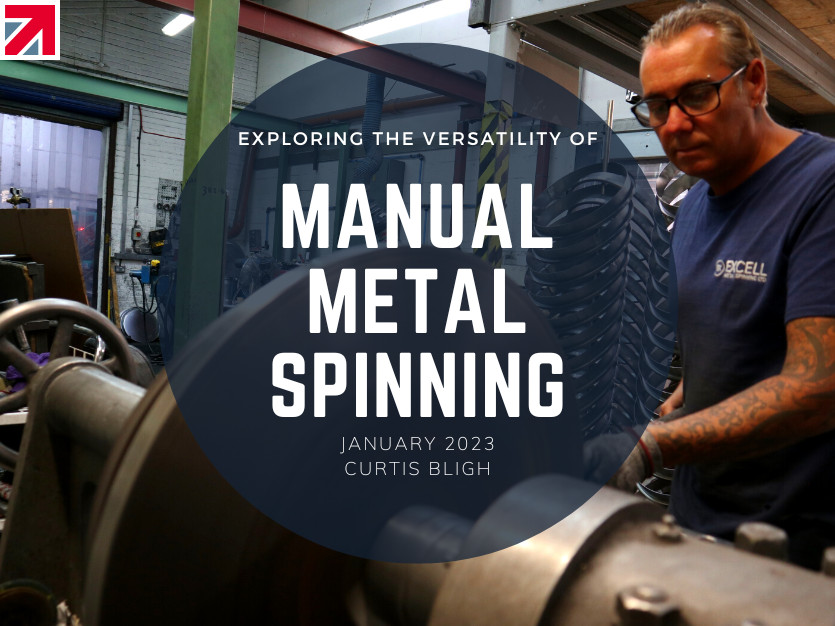Manual metal spinning, also known as hand metal spinning or spin forming, is a metalworking process in which a disk or cylinder of metal is rotated at high speed and formed into a desired shape using a hand-held tool. The process dates back to ancient times and has been used to create a wide variety of metal objects, including pots, pans, and decorative objects. Today, manual metal spinning is still used for a variety of applications, including the production of custom-made metal parts for a variety of industries.
The process of manual metal spinning begins with the selection of the appropriate metal for the desired application. Common metals used in manual metal spinning include aluminium, brass, copper, and mild steel. The metal is then cut into a disk or cylinder, which is mounted onto a lathe. The lathe is used to rotate the metal at high speeds, while the hand-held tool is used to shape the metal into the desired form.
There are several different hand-held tools that can be used in manual metal spinning, including a top tool, bottom tool, and side tool. The top tool is used to shape the top portion of the metal, while the bottom tool is used to shape the bottom portion. The side tool is used to shape the sides of the metal. Each tool is shaped in such a way as to create a specific form or shape in the metal when it is rotated against the tool.
Manual Metal Spinning Advantages
Manual Metal Spinning can prove advantageous to businesses using this process within their supply chain. One of the main advantages of manual metal spinning is its versatility. It can be used to produce a wide range of shapes and forms, including complex and irregular shapes that would be difficult or impossible to achieve using other metalworking techniques.
Traditional metalworking processes such as stamping and casting are limited to producing symmetrical shapes, but manual metal spinning allows for the creation of custom, one-of-a-kind pieces with intricate designs. This makes it an ideal choice for artistic and decorative applications, as well as for creating functional parts with unique requirements.
Another advantage of manual metal spinning is that it is a relatively low-cost process. It does not require the use of expensive machinery or tooling, and can be performed using relatively simple equipment. This makes it an attractive option for small-scale production or for companies with limited budgets.
Despite its manual nature, manual metal spinning can achieve high levels of precision and accuracy. This is due in part to the use of a mandrel, which helps to guide and shape the metal as it is spun. As a result, manual metal spinning is often used to create parts with tight tolerances and smooth finishes, such as tanks, barrels, and automotive parts.
Manual metal spinning is also a relatively fast process, as it does not require the setup and programming time that is typically required for other metalworking techniques such as CNC machining. It is also a relatively simple process to learn, as it requires only a basic understanding of metalworking principles and the use of hand-held tools.
In addition, manual metal spinning produces a high-quality finish on the surface of the metal, as the metal is formed under high pressure and is polished by the rotating tool. This can be an advantage in applications where a smooth, polished finish is desired.
Manual Metal Spinning Vs CNC Metal Spinning
Unlike CNC metal spinning, which requires the use of specialized tooling and programming, manual metal spinning can be used to produce a wide range of shapes and forms using a variety of hand-held tools. This makes it an ideal process for creating custom-made parts or one-off prototypes.
Another advantage of manual metal spinning is that it is a relatively low-cost process. It does not require the use of expensive machinery or tooling, and can be performed using relatively simple equipment. This makes it an attractive option for small-scale production or for companies with limited budgets.
Conclusion
Ultimately, manual metal spinning is a metalworking process that involves the use of a lathe and hand-held tools to shape a disk or cylinder of metal into a desired form. Manual metal spinning is a versatile and cost-effective metalworking process that allows for the creation of complex, asymmetrical shapes with high precision and accuracy. Its ability to produce small-scale runs and custom pieces make it well-suited for a wide range of applications, including artistic and decorative projects, functional parts, and prototypes.
To discuss more about your Metal Spinning requirements, fill out our Quotation Form and don’t forget to follow us on Social media for daily updates on all things Metal Spinning.
Find out more about Excell Metal Spinning Ltd on their member profile page here
Member-created content 2 years ago | From members
